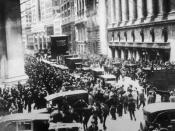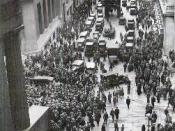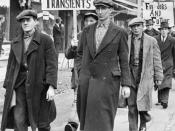To wake up in the morning, take that first deep breath as you lie in bed and stretch thinking you just had the worst dream of your life, only to roll over and relies it wasnÃÂt a dream at all. So you lay just a little longer on your concrete bed envisioning the things you once had, a home, food, and money. After lying for only a few minutes, the cold begins to creep in through your cardboard box and snip at you like a rabid dog begging for flesh, so you gather what strength you have left and crawl through the makeshift door out into a new day, with hopes of somehow finding work so you might eat.
For many this is what it was like during the Great Depression, an era in American history that most would like to forget. While some place the blame solely on the crash of Wall Street in 1929 for the cause of the depression; there are many factors that prove to have started the American economy in a downward spiral in yearÃÂs prior, making the crash of Wall Street just the icing on the cake.
While many believe that the 1920ÃÂs became an era of great prosperity for the entire nation, the cold reality is, it was prosperous only for those who didnÃÂt really need to prosper. It is true that between 1923 and 1929 the nationÃÂs income rose dramatically by approximately fifteen billion dollars, the main problem with that is it was not distributed evenly among all Americans. As the production rate for every worker increased by thirty two percent, wages for those workers only increased by eight percent, and while the cost of production became less and the cost of goods remained the same, corporations reaped the benefits. (Gusmorino, P.


